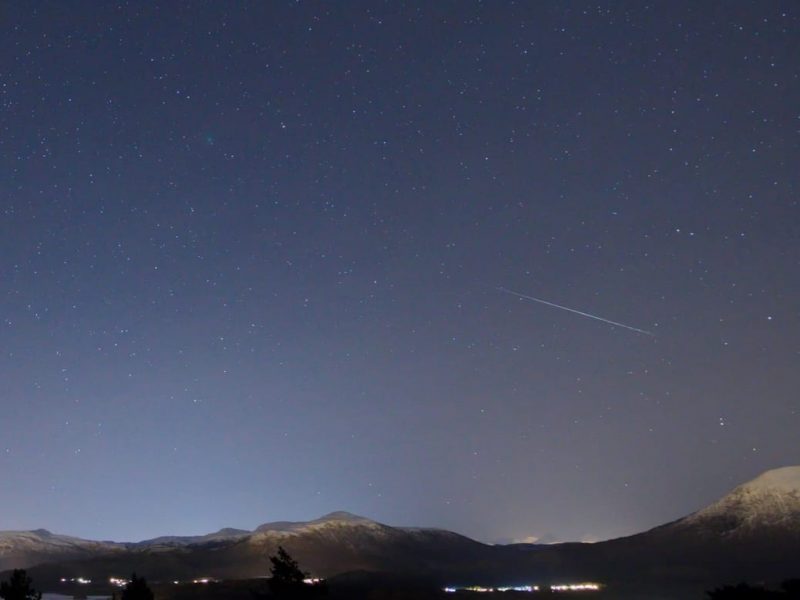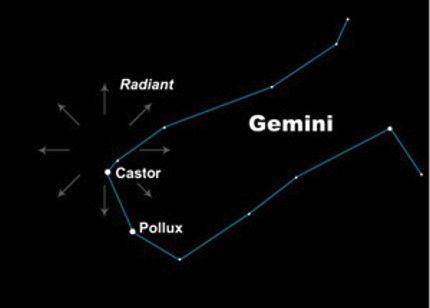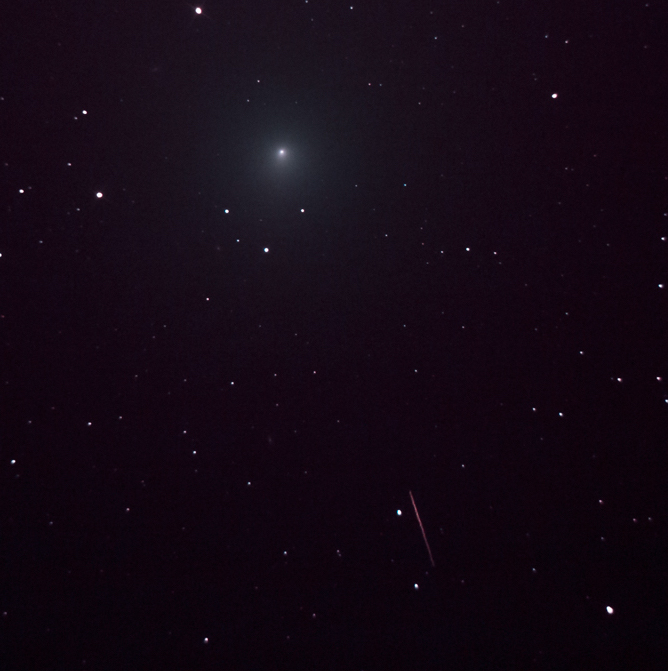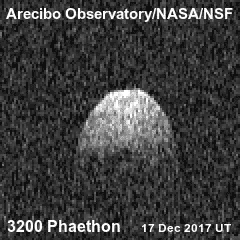

John Ashley in Glacier National Park, Montana, caught this amazing earthgrazer meteor on December 6, 2018. Earthgrazers are best seen in the evening hours. Watch for them during next week’s Geminid meteor shower! John said this one lasted approximately 4 seconds and left behind a glowing smoke train that lasted at least 24 minutes. He commented: “The meteor went dark just above Dusty Star Mountain, or ‘Iszika-kakatosi’ in Blackfeet, which translates to ‘smoking star.'” Cool! Thanks, John! Nikon D750, Rokinon 24mm lens @ f1.4, 30 sec, ISO 3200.
The Geminid meteor shower – always a highlight of the meteor year – will peak around the mornings of December 13 and 14, 2019, though under the light of a bright waning gibbous moon. The Geminids are a very reliable shower if you watch at the peak time of night (centered on about 2 a.m. for all parts of the globe) and if you watch in a dark sky. The meteors tend to be bold, white and quick. This shower favors Earth’s Northern Hemisphere, but it’s visible from the Southern Hemisphere, too. The curious rock comet called 3200 Phaethon is the parent body of this shower.
On a dark night, near the peak, you can often catch 50 or more meteors per hour. The bright moonlight this year is sure to diminish the numbers this year, but some Geminids should be bright enough to overcome the moonlit glare.
EarthSky lunar calendars are cool! They make great gifts. Order now. Going fast!

View larger. | Here’s a meteor and comet 46P/Wirtanen (upper left) from Jonny Hals in Elnesvågen, Norway. He posted this photo to EarthSky Facebook on December 12, 2018. Read about the comet.
Why are the Geminids best around 2 a.m.? It’s because that’s when the shower’s radiant point – the point in our sky from which the meteors seem to radiate – is highest in the sky. As a general rule, the higher the constellation Gemini the Twins climbs into your sky, the more Geminid meteors you’re likely to see. The Geminids’ radiant point is highest around 2 a.m.
Special equipment? None needed. Just find a dark, open sky and maybe bring a sleeping bag to keep warm. Plan to sprawl back in a hammock, lawn chair, pile of hay or blanket on the ground.
Lie down in comfort, and look upward.

Martin Marthadinata in Surabaya, East Java, Indonesia, caught this Geminid fireball in 2014, coming from the shower’s radiant point near the star Castor.

The Geminids radiate from near the bright star Castor in the constellation Gemini, in the east on December evenings, highest around 2 a.m. Learn more about the Geminids’ radiant point.
This Geminids’ radiant point nearly coincides with the bright star Castor in Gemini. That’s a chance alignment, of course, as Castor lies about 52 light-years away while these meteors burn up in the upper atmosphere, some 60 miles (100 km) above Earth’s surface.
Castor is noticeably near another bright star, the golden star Pollux of Gemini. It’s fun to spot them, but you don’t need to find a meteor shower’s radiant point to see these meteors.
Instead, meteors in annual showers appear in all parts of the sky. It’s even possible to have your back to the constellation Gemini and see a Geminid meteor fly by.

Jim Livingston in Custer, South Dakota, caught comet 46P/Wirtanen in the same field of view as a streaking meteor on December 9, 2018. See more images of comet Wirtanen. Canon 60D, Skywatcher 8″ reflector, CGX mount. Thanks, Jim!
When you’re meteor-watching, it’s good to bring along a buddy. Then two of you can watch in different directions. When someone sees one, call out “meteor!” This technique will let you see more meteors than one person watching alone will see.
Be sure to give yourself at least an hour of observing time. It takes about 20 minutes for your eyes to adapt to the dark.
Be aware that meteors often come in spurts, interspersed with lulls.

Painting of 1860 earthgrazer fireball by Frederic Edwin Church. Image via Wikimedia Commons.
Earthgrazers possible at early evening. Okay, we said you’ll likely see the most meteors at a time of night centered around 2 a.m. You won’t see as many Geminid meteors in early evening, when the constellation Gemini sits close to the eastern horizon.
But the evening hours are the best time to try to catch an earthgrazer meteor.
An earthgrazer is a slow-moving, long-lasting meteor that travels horizontally across the sky.
Earthgrazers are rarely seen but prove to be especially memorable, if you should be lucky enough to catch one.

Radar images of near-Earth asteroid 3200 Phaethon generated by astronomers at the Arecibo Observatory on December 17, 2017. The 2017 encounter was the closest the asteroid will come to Earth until 2093. Image via Wikipedia.
Geminid’s parent – 3200 Phaethon – is a “rock comet.” Every year in December, our planet Earth crosses the orbital path of an object called 3200 Phaethon, a mysterious body that is sometimes referred to as a rock comet. The debris shed by 3200 Phaethon crashes into Earth’s upper atmosphere at some 80,000 miles (130,000 km) per hour, to vaporize as colorful Geminid meteors.
In periods of 1.43 years, this small 5-kilometer (3-mile) wide asteroid-type object swings extremely close to the sun (to within one-third of Mercury’s distance), at which juncture intense thermal fracturing causes it to shed yet more rubble into its orbital stream.
There was big excitement about 3200 Phaethon in 2017, because this object was exceedingly nearby around nights of the Geminid meteor shower’s peak. It swept to within 6.4 million miles (10.3 million km, 26 lunar-distances) on December 16, 2017. In 2019, 3200 Phaethon is much farther away. Visit The Sky Live to know 3200 Phaethon’s present distance from the Earth and sun.
Read more: Mysterious rock comet 3200 Phaethon
Bottom line: The reliable Geminid meteor shower counts as one of the year’s best, but this year, in 2019, it takes place under moon-drenched skies.
from EarthSky https://ift.tt/2FXXFE5


John Ashley in Glacier National Park, Montana, caught this amazing earthgrazer meteor on December 6, 2018. Earthgrazers are best seen in the evening hours. Watch for them during next week’s Geminid meteor shower! John said this one lasted approximately 4 seconds and left behind a glowing smoke train that lasted at least 24 minutes. He commented: “The meteor went dark just above Dusty Star Mountain, or ‘Iszika-kakatosi’ in Blackfeet, which translates to ‘smoking star.'” Cool! Thanks, John! Nikon D750, Rokinon 24mm lens @ f1.4, 30 sec, ISO 3200.
The Geminid meteor shower – always a highlight of the meteor year – will peak around the mornings of December 13 and 14, 2019, though under the light of a bright waning gibbous moon. The Geminids are a very reliable shower if you watch at the peak time of night (centered on about 2 a.m. for all parts of the globe) and if you watch in a dark sky. The meteors tend to be bold, white and quick. This shower favors Earth’s Northern Hemisphere, but it’s visible from the Southern Hemisphere, too. The curious rock comet called 3200 Phaethon is the parent body of this shower.
On a dark night, near the peak, you can often catch 50 or more meteors per hour. The bright moonlight this year is sure to diminish the numbers this year, but some Geminids should be bright enough to overcome the moonlit glare.
EarthSky lunar calendars are cool! They make great gifts. Order now. Going fast!

View larger. | Here’s a meteor and comet 46P/Wirtanen (upper left) from Jonny Hals in Elnesvågen, Norway. He posted this photo to EarthSky Facebook on December 12, 2018. Read about the comet.
Why are the Geminids best around 2 a.m.? It’s because that’s when the shower’s radiant point – the point in our sky from which the meteors seem to radiate – is highest in the sky. As a general rule, the higher the constellation Gemini the Twins climbs into your sky, the more Geminid meteors you’re likely to see. The Geminids’ radiant point is highest around 2 a.m.
Special equipment? None needed. Just find a dark, open sky and maybe bring a sleeping bag to keep warm. Plan to sprawl back in a hammock, lawn chair, pile of hay or blanket on the ground.
Lie down in comfort, and look upward.

Martin Marthadinata in Surabaya, East Java, Indonesia, caught this Geminid fireball in 2014, coming from the shower’s radiant point near the star Castor.

The Geminids radiate from near the bright star Castor in the constellation Gemini, in the east on December evenings, highest around 2 a.m. Learn more about the Geminids’ radiant point.
This Geminids’ radiant point nearly coincides with the bright star Castor in Gemini. That’s a chance alignment, of course, as Castor lies about 52 light-years away while these meteors burn up in the upper atmosphere, some 60 miles (100 km) above Earth’s surface.
Castor is noticeably near another bright star, the golden star Pollux of Gemini. It’s fun to spot them, but you don’t need to find a meteor shower’s radiant point to see these meteors.
Instead, meteors in annual showers appear in all parts of the sky. It’s even possible to have your back to the constellation Gemini and see a Geminid meteor fly by.

Jim Livingston in Custer, South Dakota, caught comet 46P/Wirtanen in the same field of view as a streaking meteor on December 9, 2018. See more images of comet Wirtanen. Canon 60D, Skywatcher 8″ reflector, CGX mount. Thanks, Jim!
When you’re meteor-watching, it’s good to bring along a buddy. Then two of you can watch in different directions. When someone sees one, call out “meteor!” This technique will let you see more meteors than one person watching alone will see.
Be sure to give yourself at least an hour of observing time. It takes about 20 minutes for your eyes to adapt to the dark.
Be aware that meteors often come in spurts, interspersed with lulls.

Painting of 1860 earthgrazer fireball by Frederic Edwin Church. Image via Wikimedia Commons.
Earthgrazers possible at early evening. Okay, we said you’ll likely see the most meteors at a time of night centered around 2 a.m. You won’t see as many Geminid meteors in early evening, when the constellation Gemini sits close to the eastern horizon.
But the evening hours are the best time to try to catch an earthgrazer meteor.
An earthgrazer is a slow-moving, long-lasting meteor that travels horizontally across the sky.
Earthgrazers are rarely seen but prove to be especially memorable, if you should be lucky enough to catch one.

Radar images of near-Earth asteroid 3200 Phaethon generated by astronomers at the Arecibo Observatory on December 17, 2017. The 2017 encounter was the closest the asteroid will come to Earth until 2093. Image via Wikipedia.
Geminid’s parent – 3200 Phaethon – is a “rock comet.” Every year in December, our planet Earth crosses the orbital path of an object called 3200 Phaethon, a mysterious body that is sometimes referred to as a rock comet. The debris shed by 3200 Phaethon crashes into Earth’s upper atmosphere at some 80,000 miles (130,000 km) per hour, to vaporize as colorful Geminid meteors.
In periods of 1.43 years, this small 5-kilometer (3-mile) wide asteroid-type object swings extremely close to the sun (to within one-third of Mercury’s distance), at which juncture intense thermal fracturing causes it to shed yet more rubble into its orbital stream.
There was big excitement about 3200 Phaethon in 2017, because this object was exceedingly nearby around nights of the Geminid meteor shower’s peak. It swept to within 6.4 million miles (10.3 million km, 26 lunar-distances) on December 16, 2017. In 2019, 3200 Phaethon is much farther away. Visit The Sky Live to know 3200 Phaethon’s present distance from the Earth and sun.
Read more: Mysterious rock comet 3200 Phaethon
Bottom line: The reliable Geminid meteor shower counts as one of the year’s best, but this year, in 2019, it takes place under moon-drenched skies.
from EarthSky https://ift.tt/2FXXFE5

Aucun commentaire:
Enregistrer un commentaire